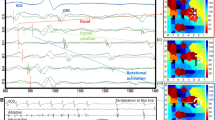Abstract
One important tool for studying ventricular fibrillation (VF) is optical mapping. Unfortunately this technique is highly prone to motion artifact. An electrocontractile uncoupler (2,3-butanedione monoxime (BDM)) is sometimes used to suppress the mechanical activity of the heart, under the assumption that this uncoupler does not affect the VF under study. Previous attempts to test this assumption have had limited spatial extent, or used optical mapping, reintroducing the confounding factor of motion artifact. Here, we test this assumption with high resolution quantitative conventional mapping. Male guinea pigs weighing more than 800 g were anesthetized using IV propofol. A median sternotomy and pericardiectomy were done to expose the heart. An intracardiac injection of BDM (0–250 mM) was given and VF was induced by 60-Hz AC stimulation. Epicardial unipolar recordings were made for 4 s using an Ag/AgCl electrode array (14 × 14) along with a video recording of the heart. The experimental procedure was repeated for control, saline, and drug. Quantitative analysis of the data was done using spatial correlation, frequency spectrum, and autocorrelation analyses. BDM significantly decreased the mechanical activity of the heart and increased the level of temporal organization during VF (reflected by frequency spectrum and autocorrelation analysis) with no changes in the level of spatial correlation. BDM does have an effect on the electrical activity of the heart along with its mechanical effects.
Similar content being viewed by others
REFERENCES
Adams W, Trafford A, and Eisner D. 2,3-Butanedione monoxime (BDM) decreases sarcoplasmic reticulum Ca content by stimulating Ca release in isolated rat ventricular myocytes. Pflugers Arch Eur J Physiol 436: 776–781, 1998.
Armas R, Gonzalez S, Brum G, and Pizarro G. Effects of 2,3-butanedione monoxime on excitation–contraction coupling in frog twitch fibres. J Muscle Res Cell Motil 19: 961–977, 1998.
Backs P, Gao W, Azan-Backx M, and Marban E. Mechanism of force inhibition by 2,3-butanedione monoxime in rat cardiac muscle: Role of ([Ca2C]i ) and cross-bridge kinetics. J Physiol 476(3): 487–500, 1994.
Bayly P, Johnson E, Wolf P, Greenside H, Smith W, and Idekar R. A quantitative measurement of spatial order in ventricular fibrillation. J Cardiovasc Electrophysiol 4: 533–546, 1993.
Biermann M, Rubart M, Moreno A, Wu J, Josiah-Durant A, and Zipes D. Differential effects of cytochalasin D and 2,3 butanedione monoxime on isometric twitch force and transmembrane action potential in isolated ventricular muscle. J Cardiovasc Electrophysiol 9: 1348–1357,1998.
Brixius K, and Schwinger R. Modulation of cross-bridge interaction by 2,3-butanedione monoxime in human ventricular myocardium. Naunyn-Schmiedeberg's Arch Pharmacol 361: 440–444, 2000.
Eynard J, and Malkin RA. Open-thorax guinea pig model for defibrillation. Lab Anim Sci 49(6): 628–633, 1999.
Ferreira G, Artigas P, Pizarro G, and Brum G. Butanedione monoxime promotes voltage-dependent inactivation of L-type calcium channels in heart. Effects on gating currents. J Mol Cell Cardiol 29: 777–787, 1997.
Garfinkel A, Kim Y, Voroshilovsky O, Qu Z, Kil J, Lee M, Karagueuzian, H, Weiss J, and Chen PS. Preventing ventricular fibrillation by flattening cardiac restitution. Proc Natl Acad Sci USA 97(11): 6061–6066, 2000.
Hui C, and Maylie J. Multiple actions of 2,3-butanedione monoxime on contractile activation in frog twitch fibres. J Physiol 442: 527–549, 1991.
Jalife J, Davidenko J, and Michaels D. A new perspective on the mechanisms of arrhythmias and sudden cardiac death: Spiral waves of excitation in heart muscle. J Cardiovasc Electrophysiol 2: S133–S152, 1991.
Lee M, Lin S, Ohara T, Omichi C, Okuyama Y, Chudin E, Garfinkel, A, Weiss J, Karagueuzian H, and Chen, PS. Effects of diacetyl monoxime and cytochalasin D on ventricular fibrillation in swine right ventricles. Am J Physiol Heart Circ Physiol 280: H2689–H2696, 2001.
Malkin RA. Constructing a multichannel electrocardiography system from a few standardized, high level components. Eng Med Biol Mag 17: 34–38, 1998.
Malkin RA, Guinn R, and Mandrell T. Water soluble propofol anesthesia: An effective and inexpensive alternative. Lab Anim 29(9): 45–47, 2000.
Malkin RA, and Pendley B. Construction of a very high-density extracellular electrode array. Am J Physiol Heart Circ Physiol 279(1): H437–H442, 2000.
Myerburg R, Kessler K, and Castellanos A. Sudden cardiac death. Structure, function, and time-dependence of risk. Circulation 85(1, Suppl) I2–I10, 1992.
Proakis J, and Manolakis D. Digital signal processing. New York: Macmillan, 1992.
Riccio M, Koller M, and Gilmour R. Electrical restitution and spatiotemporal organization during ventricular fibrillation. Circ Res 84: 955–963, 1999.
Rogers J. Needle Electrodes for transmural cardiac mapping. In Proc SBME Conf, Birmingham, Alabama, March, 2001.
Sellin L, and McArdle J. Multiple effects of 2,3-butanedione monoxime. Pharmacol Toxicol 74: 305–313, 1994.
Vaidya D, Morley G, Samie F, and Jalife J. Reentry and fibrillation in the mouse heart. A challenge to the critical mass hypothesis. Circ Res 85: 174–181, 1999.
Author information
Authors and Affiliations
Rights and permissions
About this article
Cite this article
Malik, M.G., Gopalakrishnan, M. & Malkin, R.A. Quantifying the Spatiotemporal Effects of 2,3-Butanedione Monoxime (BDM) on Ventricular Fibrillation with a Conventional Mapping System. Cardiovascular Engineering 2, 81–89 (2002). https://doi.org/10.1023/A:1023080103823
Issue Date:
DOI: https://doi.org/10.1023/A:1023080103823




